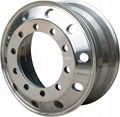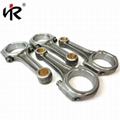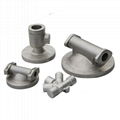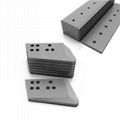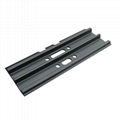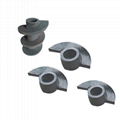| Model: | Custom-made |
|---|---|
| Brand: | HR |
| Origin: | Made In China |
| Category: | Industrial Supplies / Machinery / Cast & Forged |
| Label: | sand casting , sand castings , resin sand casting |
| Price: |
US $1.3
/ kg
|
| Min. Order: | 10000 kg |
| Last Online:10 Apr, 2018 |
Sand casting is used to make large parts (typically Iron, but also Bronze, Brass, Aluminum). Molten metal is poured into a mold cavity formed out of sand (natural or synthetic). The processes of sand casting are discussed in this section, include patterns, sprues and runners, design considerations, and casting allowance.cast iron casting
|
The cavity in the sand is formed by using a pattern (an approximate duplicate of the real part), which are typically made out of wood, sometimes metal. The cavity is contained in an aggregate housed in a box called the flask. Core is a sand shape inserted into the mold to produce the internal features of the part such as holes or internal passages. Cores are placed in the cavity to form holes of the desired shapes. Core print is the region added to the pattern, core, or mold that is used to locate and support the core within the mold. A riser is an extra void created in the mold to contain excessive molten material. The purpose of this is feed the molten metal to the mold cavity as the molten metal solidifies and shrinks, and thereby prevents voids in the main casting. cast iron casting, aluminum sand castings, grey iron casting, ductile iron casting |
|
|
|
Typical Components of a Two-part Sand Casting Mold |
|
In a two-part mold, which is typical of sand castings, the upper half, including the top half of the pattern, flask, and core is called cope and the lower half is called drag. The parting line or the parting surface is line or surface that separates the cope and drag. The drag is first filled partially with sand, and the core print, the cores, and the gating system are placed near the parting line. The cope is then assembled to the drag, andthe sand is poured on the cope half, covering the pattern, core and the gating system. The sand is compacted by vibration and mechanical means. Next, the cope is removed from the drag, and the pattern is carefully removed. The object is to remove the pattern without breaking the mold cavity. This is facilitated by designing a draft, a slight angular offset from the vertical to the vertical surfaces of the pattern. This is usually a minimum of 1?or 1.5 mm (0.060 in), whichever is greater. The rougher the surface of the pattern, the more the draft to be provided. cast iron casting |
|
Sprues and Runners |
|
The molten material is poured in the pouring cup, which is part of the gating system that supplies the molten material to the mold cavity. The vertical part of the gating system connected to the pouring cup is the sprue, and the horizontal portion is called the runners and finally to the multiple points where it is introduced to the mold cavity called the gates. Additionally there are extensions to the gating system called vents that provide the path for the built up gases and the displaced air to vent to the atmosphere.
Sand castings generally have a rough surface sometimes with surface impurities, and surface variations. A machining (finish) allowance is made for this type of defect. See casting allowance table for the finish allowance. |
|
|
|
Pattern, Finish Allowance, and Wall Thickness |
||||||||||||||||||||||||||||||||
|



